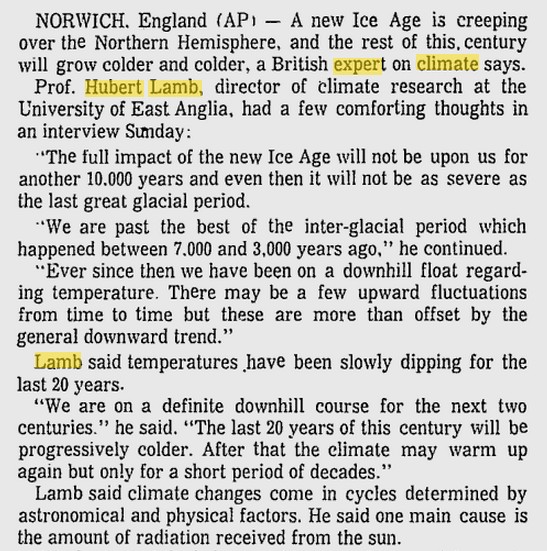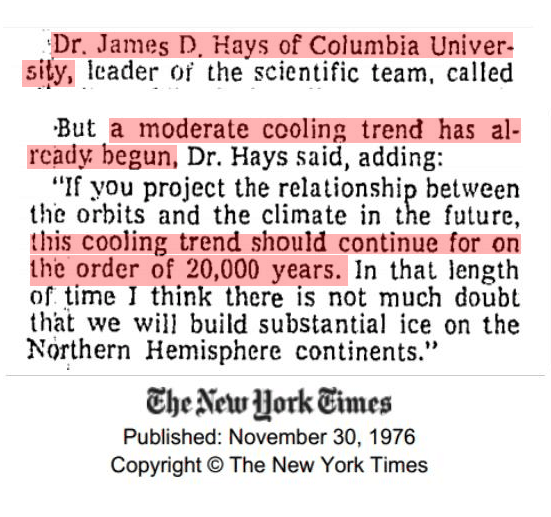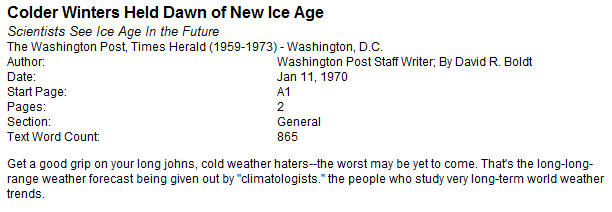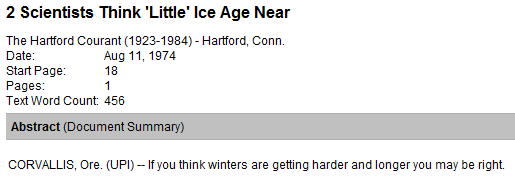You are using an out of date browser. It may not display this or other websites correctly.
You should upgrade or use an alternative browser.
You should upgrade or use an alternative browser.
climate change
- Thread starter chrysostom
- Start date
January 15, 1978


gcthomas
New member
From September 9, 1972:

Here is a fuller picture of what your source, Lamb, wrote in 1972 in his book (my bold):
It will be seen, however, that any such forecast that could be developed in the foreseeable future could only be an estimate of the 'natural' or 'undisturbed' trend, 'other things being equal'. In addition to its probably wide margin of error due to incompleteness of the scientific basis, the success of such a forecast would be threatened by the supervention of influences of a manifestly unpredictable nature - great eruptions of volcanic dust and other natural events or changes due to the works of man, intended or unintended.
Some of the possible external events that might supervene to change the course of climatic history could have effects of disastrous magnitude. Such would be the case, for example, if increasing carbon dioxide in the atmosphere were to warm the climates as much as some estimates predict, and therefore raise world sea level by melting the Antarctic ice sheet, or if certain other events were to indw;e significant cooling. Generally some regions would gain and others would lose by any changes. Further research and stock-taking of the quantities involved is urgently called for, if we are to be able to face these questions. The book provides an introductory guide to such problems.
Some of the possible external events that might supervene to change the course of climatic history could have effects of disastrous magnitude. Such would be the case, for example, if increasing carbon dioxide in the atmosphere were to warm the climates as much as some estimates predict, and therefore raise world sea level by melting the Antarctic ice sheet, or if certain other events were to indw;e significant cooling. Generally some regions would gain and others would lose by any changes. Further research and stock-taking of the quantities involved is urgently called for, if we are to be able to face these questions. The book provides an introductory guide to such problems.
You see, even Lamb recognised, in 1972, that even though the natural progression of the Earth's climate was to a distant ice-age, CO2 emissions could reverse the trend and cause major problems.
(You shouldn't rely on clippings taken out of context by climate change deniers like Stephen Goddard's Real Science blog, where you found all of your newspaper clipping imageS. Do your own research and find alternate interpretations - it doesn't take long on Google Scholar.)
You see, even Lamb recognised, in 1972, that even though the natural progression of the Earth's climate was to a distant ice-age, CO2 emissions could reverse the trend and cause major problems.
Did you read what else Lamb said in the excerpt you posted?
Let's take a look:
"and therefore raise world sea level by melting the Antarctic ice sheet"
Well....that's not only not happening, the exact opposite is happening. There is more Antarctic ice today than ever before.
All this does is prove Lamb, and every other scientist has no idea what they're talking about.
Yet, you guys keep believing them.
Well, perhaps tetelestai didn't get it the first time. Let's show it to him again...
tetelestai writes:
Barbarian chuckles:
Sorry, you were suckered on that story, too...
However, these are media articles, not scientific studies. A survey of peer reviewed scientific papers from 1965 to 1979 show that few papers predicted global cooling (7 in total). Significantly more papers (42 in total) predicted global warming (Peterson 2008). The large majority of climate research in the 1970s predicted the Earth would warm as a consequence of CO2. Rather than 1970s scientists predicting cooling, the opposite is the case.
http://skepticalscience.com/ice-age-...termediate.htm

Surprise.
tetelestai writes:
In 1979 all the climatologists and Chicken Littles were telling us an ice age was coming.
Barbarian chuckles:
Sorry, you were suckered on that story, too...
However, these are media articles, not scientific studies. A survey of peer reviewed scientific papers from 1965 to 1979 show that few papers predicted global cooling (7 in total). Significantly more papers (42 in total) predicted global warming (Peterson 2008). The large majority of climate research in the 1970s predicted the Earth would warm as a consequence of CO2. Rather than 1970s scientists predicting cooling, the opposite is the case.
http://skepticalscience.com/ice-age-...termediate.htm

Surprise.
July 12, 1976


Well, perhaps tetelestai didn't get it the first time. Let's show it to him again...
I get it.
It's you who is wrong.
You're article and chart mean nothing. It's nothing more than trying to rewrite history.
April 28, 1975




Did you read what else Lamb said in the excerpt you posted?
Let's take a look:
"and therefore raise world sea level by melting the Antarctic ice sheet"
Well....that's not only not happening, the exact opposite is happening. There is more Antarctic ice today than ever before.
You were fooled yet again. The amount of ice in the ocean increases around Antarctica, as predicted, but Antarctic ice sheet is melting at an increasing rate.
Science 14 June 2002:
Vol. 296 no. 5575 pp. 2020-2023
Rapid Bottom Melting Widespread near Antarctic Ice Sheet Grounding Lines
As continental ice from Antarctica reaches the grounding line and begins to float, its underside melts into the ocean. Results obtained with satellite radar interferometry reveal that bottom melt rates experienced by large outlet glaciers near their grounding lines are far higher than generally assumed. The melting rate is positively correlated with thermal forcing, increasing by 1 meter per year for each 0.1°C rise in ocean temperature. Where deep water has direct access to grounding lines, glaciers and ice shelves are vulnerable to ongoing increases in ocean temperature.
...
Warm ocean is eroding West Antarctic Ice Sheet
Geophysical Research Letters
Volume 31, Issue 23, 16 December 2004
Satellite radar measurements show that ice shelves in Pine Island Bay have thinned by up to 5.5 m yr−1 over the past decade. The pattern of shelf thinning mirrors that of their grounded tributaries - the Pine Island, Thwaites and Smith glaciers - and ocean currents on average 0.5°C warmer than freezing appear to be the source. The synchronised imbalance of the inland glaciers is the result of reduced lateral and basal tractions at their termini, and the drawdown of grounded ice shows that Antarctica is more sensitive to changing climates than was previously considered.
...
Antarctic ice-sheet loss driven by basal melting of ice shelves
Nature 484, 502–505 (26 April 2012)
We deduce that this increased melt is the primary control of Antarctic ice-sheet loss, through a reduction in buttressing of the adjacent ice sheet leading to accelerated glacier flow2. The highest thinning rates occur where warm water at depth can access thick ice shelves via submarine troughs crossing the continental shelf. Wind forcing could explain the dominant patterns of both basal melting and the surface melting and collapse of Antarctic ice shelves, through ocean upwelling in the Amundsen6 and Bellingshausen7 seas, and atmospheric warming on the Antarctic Peninsula8. This implies that climate forcing through changing winds influences Antarctic ice-sheet mass balance, and hence global sea level, on annual to decadal timescales.
All this does is prove Lamb, and every other scientist has no idea what they're talking about.
See above. You've been suckered again.
Yet, you guys keep believing them.
It's that evidence thing, again. Go figure.
I get it.
Not at all. You're still trying to pass off newspaper and magazine articles as scientific consensus. No one is fooled.
You're article and chart mean nothing.
It's just a survey of what the scientific consensus was at the time. As you learned even then, climatologists were aware of increasing warming in the world.
Your stories are nothing more than trying to rewrite history.
It's that evidence thing, again. Go figure.
You have no evidence.
The evidence is that there is more ice in the Antarctic right now than ever before.
It's why the idiots you follow got stuck in the ice trying to go there last year to tell people like you the ice is melting.
The only think dumber than believing the Antarctic ice is melting, is believing people who got stuck in Antarctic ice on a ship, telling you the ice is melting.
You're still trying to pass off newspaper and magazine articles as scientific consensus.
I'm stopping you and your fellow Chicken Littles from trying to rewrite history.
I lived in the 70's. I remember it well. I remember what they taught us in science class.
The newspaper articles I have posted prove that climatologists and other scientists in the 70's thought an ice age was coming.
They were dead wrong, and now people like you are trying to rewrite history because you know how foolish you and they look.
Selaphiel
Well-known member
I'm stopping you and your fellow Chicken Littles from trying to rewrite history.
I lived in the 70's. I remember it well. I remember what they taught us in science class.
The newspaper articles I have posted prove that climatologists and other scientists in the 70's thought an ice age was coming.
They were dead wrong, and now people like you are trying to rewrite history because you know how foolish you and they look.
You are demonstrably wrong. The barbarian showed you why, it is simply a fact that the prediction of cooling was a minority position in the 70s as well. It is a simple fact demonstrated by metastudies of the peer reviewed papers from that era.
"However, these are media articles, not scientific studies. A survey of peer reviewed scientific papers from 1965 to 1979 show that few papers predicted global cooling (7 in total). Significantly more papers (42 in total) predicted global warming (Peterson 2008)."
Peterson study: http://nora.nerc.ac.uk/11584/1/2008bams2370%252E1.pdf
What you remember from science class and a variety of newspaper clippings isn't even remotely relevant. The fact that you do not even understand the difference between a newspaper/magazine article and a peer reviewed scientific paper is enough to demolish whatever credibility you had.
You simply have no idea what you are talking about.











